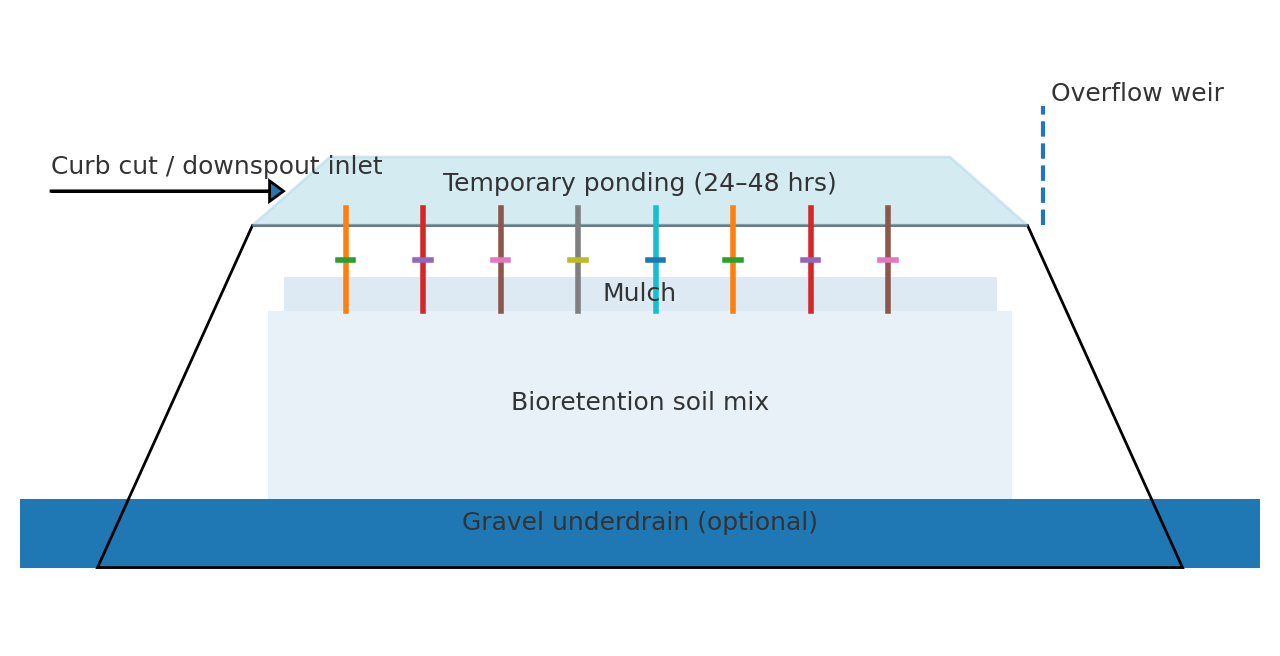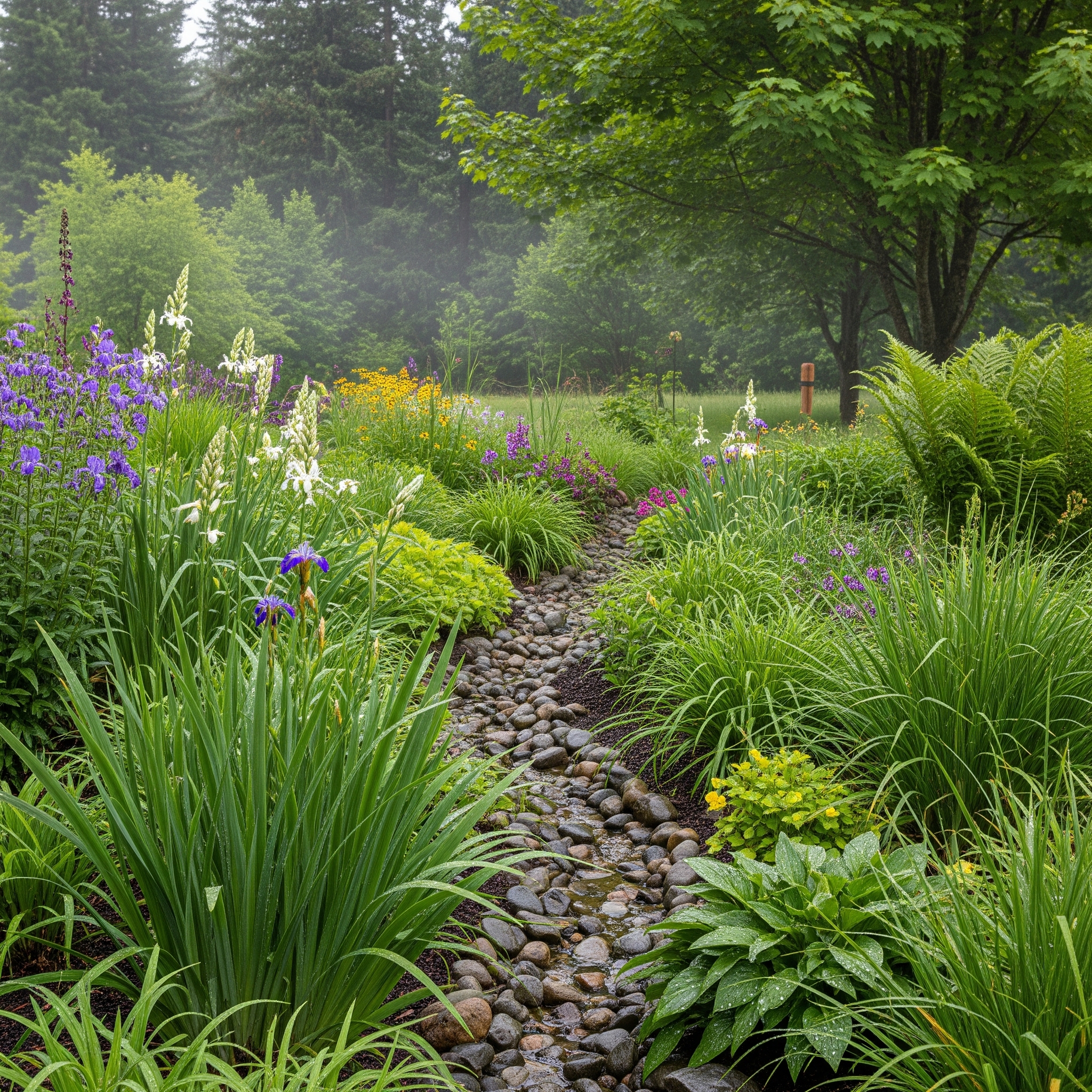
Rain Gardens: Small Basins, Big Impact
Nature-based stormwater, biodiversity, and public-space benefits for Northern California
Executive Summary
Rain gardens are shallow, vegetated basins that intercept runoff from hard surfaces, allow it to soak through engineered soils, and release it slowly into the ground. When designed correctly, rain gardens reduce localized flooding and sewer overflows, filter pollutants, recharge groundwater, cool overheated streets, and create attractive habitat for pollinators and people. This brief adapts proven design practices to Northern California’s climate, soils, and native plant palette.
What is a Rain Garden?
A rain garden is a slightly depressed landscape bed filled with a layered “sponge”: a gravel underdrain (where needed), a sand/compost/loam mix that drains rapidly, and dense plantings of native grasses, forbs, and shrubs. The garden intercepts water from roofs, driveways, and streets; water pools briefly (typically less than a day) and then infiltrates. In doing so, rain gardens reduce peak flows to storm sewers, trap sediment and nutrients, and improve downstream water quality.
How a Rain Garden Works
The basic sequence: capture → settle & filter → soak → overflow (only during very large storms) → evapotranspiration & habitat.

Figure 1. Simplified rain garden schematic showing basin geometry, soil layers, inlet, and overflow.
Benefits
- Flood risk reduction & sewer relief.
Street-side rain gardens (green streets) slow and absorb runoff, reducing backups and combined sewer overflows while protecting rivers.
- Cleaner water.
Soils and plant roots filter nutrients, hydrocarbons, and metals, improving the quality of water that recharges aquifers or enters streams.
- Urban heat relief & public realm.
Vegetation and evapotranspiration reduce surface temperatures and add attractive, traffic-calming green edges to streets and lots.
- Biodiversity & education.
Flowering natives support pollinators and create outdoor learning spaces in schools and parks.
Where Rain Gardens Fit
Rain gardens can be integrated into residential yards (at least ~10 feet from foundations), streetscapes (curb extensions and bump-outs), parking lots (end-of-row islands), and parks or campuses (perimeter swales and basins). Avoid areas with seasonally high groundwater, steep slopes, or contaminated soils; on heavy clays, use a shallower basin and consider an underdrain.
Design Essentials for Northern California
Sizing. Start with an area roughly 5–10% of the contributing impervious surface, then adjust for local infiltration rates and design storms.
Soils. Use a free-draining bioretention mix (often 60–80% sand with compost and topsoil) to achieve 24–48 hour drawdown; avoid overly rich mixes that leach nutrients.
Hydraulics & safety. Provide pretreatment (a small forebay or rock check), set a clear overflow weir, and ensure visibility for drivers and pedestrians.
Maintenance. Expect weeding and watering during the first two seasons; refresh mulch annually and clear inlets after big storms.
Simple Native Planting Palette, Example: Northern California
Select species tolerant of seasonal inundation and summer dry-down. Group plants by zone: basin bottom (wettest), side slopes (periodically wet), and rim/upland (driest). Plant densely (12–18 in. spacing) to stabilize soil and outcompete weeds.
| Zone | Common Name | Scientific Name | Mature Height | Bloom Window | Wildlife Value | Notes | |
| Basin bottom | California Gray Rush | Juncus patens | 2–3 ft | Spring–Fall | Pollinator cover; nesting material | Workhorse for wet/dry cycles; evergreen clumps | |
| Basin bottom | Creeping Wild Rye | Elymus (Leymus) triticoides | 2–4 ft | Spring | Bird seed/cover | Handles periodic inundation; strong rhizomes bind soil | |
| Basin bottom | Baltic Rush | Juncus balticus | 2–3 ft | Spring–Summer | Cover for amphibians/invertebrates | Good for heavier soils | |
| Side slope | Blue-eyed Grass | Sisyrinchium bellum | 6–18 in | Winter–Spring | Early nectar for insects | Tolerates moist winters and dry summers | |
| Side slope | California Goldenrod | Solidago velutina ssp. californica | 2–4 ft | Summer–Fall | Late-season pollinators | Spreads to knit slopes; cut back in winter | |
| Side slope | Yarrow (native type) | Achillea millefolium var. californica | 1–2 ft | Spring–Summer | Butterflies & beneficial insects | Tough, good for edges and gaps | |
| Side slope | Douglas Iris | Iris douglasiana | 1–2 ft | Winter–Spring | Bees & early pollinators | Evergreen fans; prefers some moisture | |
| Rim/upland | California Fuchsia | Epilobium canum | 1–2 ft | Late Summer–Fall | Hummingbirds | Thrives on drier rim; spectacular late color | |
| Rim/upland | Hummingbird Sage | Salvia spathacea | 1–2 ft | Spring | Hummingbirds & bees | Fragrant foliage; part shade tolerant | |
| Rim/upland | Coyote Mint | Monardella villosa | 1–2 ft | Summer | Native bees & butterflies | Aromatic; good for sunny, drier edges | |
| Shrub (slope/rim) | Western Redbud | Cercis occidentalis | 8–15 ft | Spring | Early nectar; bird habitat | Small tree/shrub; good structure near overflow | |
| Shrub (slope/rim) | Golden Currant | Ribes aureum var. gracillimum | 4–8 ft | Spring | Pollinators; bird fruit | Tolerates seasonal moisture and summer dry | |
Note: Availability varies by nursery. Favor local ecotypes where possible and avoid invasive look-alikes. In curbside sites, maintain sightlines and keep taller shrubs away from corners and driveways.
Real-World Examples
- Portland, OR – “Green Streets” curb-extension rain gardens embedded within city right-of-way to intercept street runoff.
Seattle/King County, WA – “RainWise” residential rain garden rebates popularized homeowner adoption in combined-sewer basins. - Philadelphia, PA – “Green City, Clean Waters” uses rain gardens, bump-outs, and tree trenches to reduce sewer overflows.
- Sheffield, UK – “Grey to Green” converted excess roadway to linear rain gardens that double as public realm improvements.
- Melbourne, AU – Widespread “raingardens” under a water-sensitive urban design approach across neighborhoods and corridors.
Maintenance Checklist (Years 0–2 and Beyond)
Inspect after the first big storms; confirm water drains within 24–48 hours.
Weed monthly in the first growing season; spot-mulch bare soil with shredded mulch or gravel that will not float.
Clear inlets/forebays after storms; remove accumulated sediment and litter.
Water new plantings through the first two dry seasons, then taper.
Cut back herbaceous perennials annually; thin aggressive spreaders as needed.
Getting Started
Always consult with a licensed professional – a civil engineer or a Landscape architect would be typical, however first consult with the local city and discuss your ideas. The City should advise what type of professional you need on your project. Begin with the cleanest water first, roof leaders, and size multiple small basins rather than one large pit. Call 811 before you dig to locate utilities. Where soil is heavy clay, use shallower basins and consider an underdrain connected to a safe discharge point.
Author: Robert Ancill of The Next Idea Group, [TNI]




